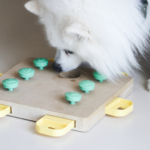Introduction
In a world increasingly focused on environmental consciousness, responsible pet ownership extends beyond providing love and care to our furry companions. This guide dives into the realm of sustainable living for eco-friendly dog owners, shedding light on eco-friendly practices that benefit both the planet and our pets.
The Green Dog Diet
In the era of environmental consciousness, pet owners are increasingly seeking sustainable alternatives to reduce their furry friends’ ecological pawprints. The Green Dog Diet represents a conscientious approach to pet nutrition, focusing on sustainable and nutritious choices that benefit both your dog’s health and the environment.
One significant aspect of the Green Dog Diet is the exploration of Plant-Based Dog Food Options. By incorporating plant-based and vegetarian dog food into your pet’s diet, you contribute to the reduction of the environmental impact associated with conventional meat production. These plant-based alternatives offer a nutritionally balanced diet for dogs, often rich in essential nutrients like proteins sourced from plants.
Equally important in the Green Dog Diet is the consideration of Eco-Friendly Packaging. Opting for brands that prioritize sustainable packaging materials reduces the carbon footprint associated with your dog’s meals. Look for recyclable or biodegradable packaging options, minimizing waste and promoting responsible consumption.
Understanding the Impact of Meat Consumption on the Environment is crucial for environmentally conscious pet owners. The production of conventional meat has significant environmental consequences, including deforestation, greenhouse gas emissions, and water pollution. By choosing plant-based alternatives, pet owners actively participate in reducing the demand for resource-intensive meat production, contributing to a more sustainable planet.
Waste Not, Wag More
Pet waste disposal poses environmental challenges, with traditional methods contributing to pollution and landfill waste. Adopting eco-friendly alternatives not only addresses these challenges but also promotes a sustainable approach to managing your pet’s waste. Let’s explore some green solutions to make pet waste disposal more environmentally friendly.
One key challenge is the prevalence of plastic poop bags that contribute to the ever-growing plastic pollution crisis. Enter Biodegradable Poop Bags—a sustainable alternative. These bags break down naturally, reducing the environmental impact of plastic waste. Choosing biodegradable options ensures that your efforts in waste disposal align with eco-conscious practices.
Composting offers another innovative solution for managing dog waste in an environmentally friendly way. Designate a specific area in your yard for a Dog Waste Composting System. With the right composting setup, dog waste can be turned into nutrient-rich fertilizer for non-edible plants. This not only diverts waste from landfills but also transforms it into a resource for your garden.
When considering composting, it’s essential to use dedicated compostable bags designed for pet waste. These bags break down alongside the waste, facilitating the composting process without adding harmful materials to the mix.
Educating pet owners about the benefits of composting dog waste and using biodegradable poop bags fosters a shift towards eco-friendly practices. Communities can come together to implement local composting programs for pet waste, reducing the collective environmental impact.
Eco-Friendly Pet Products
Durable Materials for Accessories: When selecting pet accessories like collars, leashes, and harnesses, opt for those made from durable and long-lasting materials. Eco-friendly choices include hemp, bamboo, or recycled materials. These options not only withstand wear and tear but also reduce the need for frequent replacements, minimizing waste.
Biodegradable Toys: Many conventional pet toys contribute to the global plastic problem. Choosing toys made from biodegradable materials, such as natural rubber or plant-based plastics, ensures that your pet’s playtime doesn’t come at the cost of the environment. These toys break down over time, leaving behind minimal ecological impact.
Upcycled Bedding: Provide your pet with a cozy and sustainable place to rest by opting for bedding made from upcycled materials. Upcycled pet beds often repurpose materials that would otherwise go to waste, such as old clothing or fabrics. Not only does this reduce the demand for new resources, but it also adds a unique and personalized touch to your pet’s sleeping space.
Pawsitively Green Grooming
Natural and Cruelty-Free Products: Choosing grooming products that are both natural and cruelty-free is a fundamental step towards eco-conscious pet care. Look for shampoos, conditioners, and grooming sprays that boast plant-based ingredients, avoiding harmful chemicals that can harm your pet and the environment. Additionally, opt for brands committed to cruelty-free practices, ensuring no animals suffer during the production process.
Water-Saving Techniques: Conserving water is a crucial aspect of eco-friendly grooming. Rather than leaving the tap running during your pet’s bath, use a bucket or a water-saving nozzle to control water usage. Consider washing your pet on a grassy area, allowing the water to nourish the plants. This mindful approach reduces water waste and minimizes the environmental impact of your grooming routine.
Benefits of DIY Grooming: DIY grooming not only strengthens the bond between you and your pet but also reduces the carbon footprint associated with professional grooming services. Invest in high-quality grooming tools, such as combs and brushes made from sustainable materials, and learn basic grooming techniques at home. Not only will you save resources, but you’ll also have more control over the products used on your pet.
Sustainable Outdoor Adventures
Reusable Essentials: One of the simplest ways to make outdoor adventures eco-friendly is by swapping single-use items for reusable alternatives. Invest in durable and reusable water bottles to stay hydrated during your outings. Portable bowls made from eco-friendly materials ensure your pet stays hydrated too, without contributing to plastic waste.
Eco-Friendly Travel Destinations: Choose destinations that prioritize sustainability and conservation. Opt for parks, trails, or camping sites that have eco-friendly initiatives in place. Research pet-friendly destinations that actively support environmental conservation, promoting a harmonious coexistence between pets, nature, and responsible tourism.
Respect for Natural Habitats: Practicing Leave No Trace principles is essential when venturing into natural habitats. Keep your dog on designated trails to prevent damage to fragile ecosystems, and respect wildlife by observing from a distance. Proper waste disposal, including pet waste, ensures that these pristine areas remain unspoiled for future generations.
Sustainable Gear Choices: When selecting outdoor gear for your pet, prioritize sustainable materials and products. Look for eco-friendly collars and leashes made from recycled or biodegradable materials. Choose gear from companies committed to environmentally conscious manufacturing practices, reducing your carbon footprint in the process.
Conclusion
In conclusion, adopting sustainable practices in pet care not only benefits the environment but also contributes to the well-being of our beloved pets. By making conscious choices, we can create a greener, healthier, and happier world for both humans and their furry companions.









